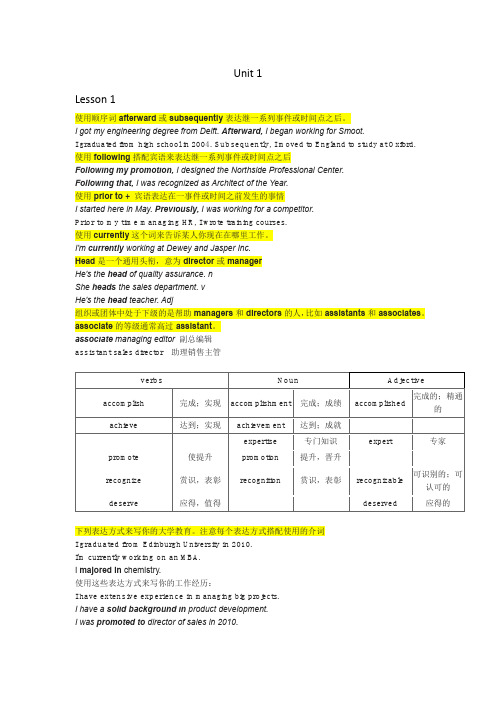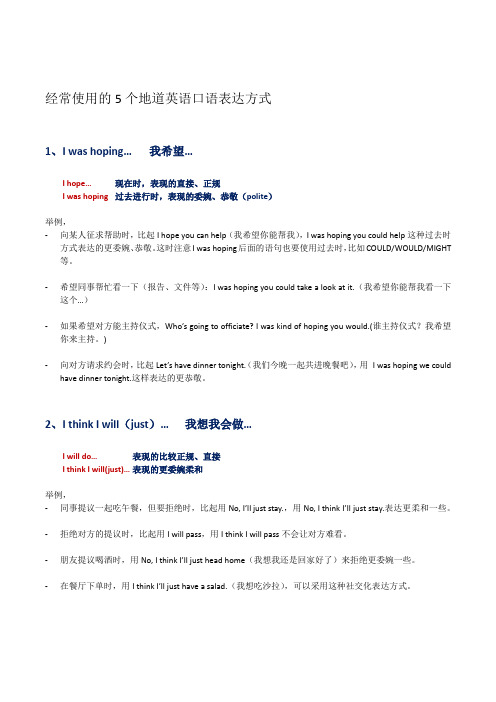英语表达方式汇总
英语常用表达形式汇总

Unit 1Lesson 1使用顺序词afterward或subsequently表达继一系列事件或时间点之后。
I got my engineering degree from Delft. Afterward, I began working for Smoot.I graduated from high school in 2004. Subsequently, I moved to England to study at Oxford.使用following搭配宾语来表达继一系列事件或时间点之后Following my promotion, I designed the Northside Professional Center.Following that, I was recognized as Architect of the Year.使用prior to + 宾语表达在一事件或时间之前发生的事情I started here in May. Previously, I was working for a competitor.Prior to my time managing HR, I wrote training courses.使用currently这个词来告诉某人你现在在哪里工作。
I'm currently working at Dewey and Jasper Inc.Head是一个通用头衔,意为director或managerHe's the head of quality assurance. nShe heads the sales department. vHe's the head teacher. Adj组织或团体中处于下级的是帮助managers和directors的人,比如assistants和associates。
associate的等级通常高过assistant。
英语中常见的正式表达方式与非正式表达方式

在正式的场合需要使用正式的表达方式,表达敬意和严谨;在非正式场合使用非正式的表达方式,拉近彼此之间的距离,提高谈话的弹性和舒适性,以下列举常见的正式表达方式与对应的非正式表达方式。
1. 你好吗?How do you do? >>——-<< What’s up?解析:What's up 的发音还可以是 wassup 或 whaddup,在非正式场合中,”What's up“ 是一个非常随便的问候语,表面上译为”怎么了或发生什么事了“,实际上不涉及对某些事的具体更新信息,相当于 what is the matter 或 what is happening,例如:'What's up?', I said to him.—'Nothing much,' he answered.“怎么了?”,我对他说。
—没什么,他回答。
2. 很高兴见到你It is a pleasure to meet you >>——<< Nice to meet you3. 在你方便的时候尽早At your earliest convenience >>——<< As soon as you can4. 担心你,关心你Concerned about you >>——<< Worried about you5. 首先Firstly , >>——<< To start with/…, For a start6. 代我向…问好Give my regards to >>——<< Say hello to7. 你最近有她的消息吗?Have you heard from her lately? >>——<< Heard from her lately?8. 你看到过汤姆吗?Have you seen Tom? >>——<< Seen Tom?9. 我同意安娜…的看法/安娜是正确的I agree with my colleague, Anna, that… >>——<< Anna’s right.10. 我想提醒你的是…I would like to remind you that… >>——<< Don’t forget11. 非常感谢I appreciate your assistance ! >>——<< Thanks a lot!12. 由于…In light of the fact that >>——<< Because13. 我认为…It is my opinion that… >>——<< I think…14. 我需要做…It is necessary for me to… >>——<< I need to…15. 你不必…It is not necessary for you to… >>——<< You don’t hafta (不得不,只好)…16. 我们建议…It is recommended >>——<< We recommend17. 很抱歉,…/因…,很抱歉Please accept our apologies for… >>——<< Sorry…18. 而且,此外Secondly/ Besides / Furthermore, >>——<< Another good thing is/ What’s more/ Not only that,19. 最后Lastly, >>——<< And one of the best things is…/ And best of all, / The most important thing is…20. 她能…She has the ability >>——<< She can21. 该计划已付诸实践The plan was implemented / carried out >>——<< They put the plan into action22. 我们的目的地Our destination >>——<< The place where we want to go23. 我很抱歉地通知你…I regret to inform you of… >>——<< I’m sorry to tell you that…24. 你能…I was hoping that you could… >>——<< Could you…?25. 不成问题It will cease to be a problem >>——<< It won’t be a problem anymore26. 人们开始厌倦这些事。
有趣的英语表达方式

有趣的英语表达方式
1. "It's raining cats and dogs" - 表示雨下得很大。
2. "Break a leg!" - 用于祝福某人好运,尤其是在表演或比赛时。
3. "Once in a blue moon" - 意味着非常少见或罕见的事情。
4. "Bite the bullet" - 意味着勇敢地面对困难或不愉快的情况。
5. "Cost an arm and a leg" - 意味着某物非常昂贵。
6. "Hit the hay" - 意味着去睡觉。
7. "Piece of cake" - 意味着某事非常容易。
8. "Don't put all your eggs in one basket" - 告诫不要把所有希望
或资源放在一个地方。
9. "Spill the beans" - 意味着泄露秘密或透露不该透露的信息。
10. "Kill two birds with one stone" - 一箭双雕,一次解决两个问题。
英语口语10种表达方式

英语口语10种表达方式学习英语一定要按照方法来,要不然会一直提升不了成绩的,今天小编就给大家分享一下英语的学习方法,有时间可以看看哦学习方法一1. root around翻找,翻寻root的本意是根;根源,作动词表达翻找,翻寻,这个短语尤指在其他物品中寻找,搜寻。
She rooted through/among the papers on her desk.她在桌上的文件中翻来翻去地找东西。
2. poke around搜索;翻找poke主要指用手指、工具或器具去“戳,刺,捅”,如果你想说“扎心了,老铁”,就可以来一句You poked my heart!I was poking around in the drawer, looking for the key, when I found this!我在抽屉里翻来翻去找钥匙,就在这时找到了这个!3. rummage翻找,翻寻,乱翻rummage常和in/through搭配,形容翻箱倒柜地寻找。
She rummaged in/through all the drawers, looking for a pen.她把所有抽屉都翻了个遍,想找支笔。
4. turn sth upside down将…翻了个底朝天这个短语指你搜遍了整个角落,常常还留下一片狼藉。
I turned the apartment upside down but I couldn't find the letter.我把公寓翻了个底朝天也还是找不着那些照片。
5. rifle迅速翻查;匆忙翻找rifle就是“来福枪;步枪”的意思,当它用作动词,就表示匆忙翻找某物,经常指偷盗行为。
The safe had been rifled and the diamonds were gone.保险柜被洗劫了,钻石不翼而飞。
6. trawl搜寻;网罗trawl表示搜寻的时候,指的是为了得到自己想要的而搜寻大量的信息。
经常使用的地道英语5个表达方式

经常使用的5个地道英语口语表达方式1、I was hoping…我希望…I hope…现在时,表现的直接、正规I was hoping过去进行时,表现的委婉、恭敬(polite)举例,-向某人征求帮助时,比起I hope you can help(我希望你能帮我),I was hoping you could help这种过去时方式表达的更委婉、恭敬。
这时注意I was hoping后面的语句也要使用过去时,比如COULD/WOULD/MIGHT 等。
-希望同事帮忙看一下(报告、文件等):I was hoping you could take a look at it.(我希望你能帮我看一下这个…)-如果希望对方能主持仪式,Who’s going to officiate? I was kind of hoping you would.(谁主持仪式?我希望你来主持。
)-向对方请求约会时,比起Let’s have dinner tonight.(我们今晚一起共进晚餐吧),用I was hoping we could have dinner tonight.这样表达的更恭敬。
2、I think I will(just)…我想我会做…I will do…表现的比较正规、直接I think I will(just)…表现的更委婉柔和举例,-同事提议一起吃午餐,但要拒绝时,比起用No, I’ll just stay.,用No, I think I’ll just stay.表达更柔和一些。
-拒绝对方的提议时,比起用I will pass,用I think I will pass不会让对方难看。
-朋友提议喝酒时,用No, I think I’ll just head home(我想我还是回家好了)来拒绝更委婉一些。
-在餐厅下单时,用I think I’ll just have a salad.(我想吃沙拉),可以采用这种社交化表达方式。
英语常用表达方法整理

1.I've been back and forth. 我犹豫不定。
2.I'm feeling blue today。
我今天心情不好。
3. This is so meant to be! 这就是天意!4. She's gonna be crushed. 她会崩溃的。
5. He can't come to the phone now. 他现在不能接电话6. talk sb. up 说好话7. I can't feel my hands. 我手麻了。
8. I saw a lot of stuff. 我大开眼界了。
9. work an extra shift 多值一轮班10.I have part of the fault. 我也有责任。
11. organize my thoughts 整理思绪12. get a little preoccupied 事先有事13. enough is enough!够了14. I thought it was the other way around 我以为是反过来的15. close my bank account 注销银行卡16. I feel wild today 我今天好亢奋!17. I'm kind of beat 我有点累了18. Can u get the door? 你能去开门吗19, make a huge fool of oneself 出洋相20. any luck?找到了吗?21. It doesn't count. 那不算。
22. overreact 反应过度23, patch things up with sb.和某人修复关系24. how did it go?怎么样?24. cut him some slack 放他一马25. get over with 忘记26. get in line排队(everybody get in line)大家排好队27. I don't have the energy for this 我没有能力应付这个28. You got me.你还真问住我了29. I wasn't born yesterday.我又不是三岁小孩。
英语中常用的语言表达方式

英语中常用的语言表达方式英语是一门广泛使用的国际语言,是全球通用的商务语言和科学技术语言。
随着全球化加速,学好英语变得愈发重要。
但是,用英语表达自己的意思是需要一定技巧和经验的。
我们需要掌握一些常用的语言表达方式,以在交流中更加流畅自如。
1.常用交际用语在英语交流中,首先必备的是日常交际用语。
例如,问候语和礼貌用语,如“Good morning,how are you? ”和“Excuse me,could you please tell me the time?”这些表达方式不仅可以让我们与别人建立友好关系,还能让我们更好地得到对方的帮助。
2.常用口语表达英语口语是最具挑战性的部分之一。
我们需要学习地道的口语表达方式,以免被人误解或误解别人。
例如,掌握一些日常用语,比如“it’s a piece of cake”(非常容易),“Break a leg”(祝你好运)等。
这些口语表达方式不仅能让我们感受到语言的魅力,还能大大提升我们的语言水平。
3. 常用问句在日常英语中,问句是必不可少的。
掌握各种类型问句的用法和意义,是良好的交际能力的体现。
例如,疑问句,“Are yousure?”和陈述句“you are sure”在表达上是有区别的。
学会运用不同类型的问句是建立语境,更好地获得信息的关键。
4. 常用缩略语和词组缩略语和词组通常用于商务英语和科技英语中,包括电子邮件,商务信函和科技报告等。
学习这些缩略语和词组能大大加快我们的阅读速度和理解能力。
例如,“ASAP”(尽快),“FYI”(供您参考),“e.g”(例如),“etc”(例如)。
越来越多的缩略语和词组已经成为了英语语言的一部分,掌握这些常用的表达方式有助于更好地融入到英语环境中。
总而言之,掌握英语中的各种表达方式对于打好英语基本功是至关重要的。
通过不断地练习和学习,我们能更好地表达自己的意思和更好地与别人交流,使我们的语言表达更具有说服力和魅力。
初中英语知识归纳常见句型和表达方式

初中英语知识归纳常见句型和表达方式初中英语知识归纳:常见句型和表达方式在初中英语学习中,熟练掌握常见的句型和表达方式是非常重要的。
下面将对初中英语常见的句型和表达方式进行归纳总结,帮助学生更好地应用于实际场景中。
一、询问与回答个人信息的句型:1. What’s your name?(你叫什么名字?)- My name is…(我叫……)2. How old are you?(你今年几岁了?)- I am … years old.(我……岁)3. Where are you from?(你来自哪里?)- I am from…(我来自……)4. What’s your favorite subject?(你最喜欢的科目是什么?)- My favorite subject is…(我最喜欢的科目是……)二、询问与回答关于家庭的句型:1. How many people are there in your family?(你家有几口人?)- There are … people in my family.(我家有……口人)2. Do you have any siblings?(你有兄弟姐妹吗?)- Yes, I have … siblings.(是的,我有……个兄弟姐妹)3. What does your father/mother do?(你爸爸/妈妈是做什么的?)- My father/mother is a…(我爸爸/妈妈是一个……)4. Where do you live?(你住在哪里?)- I live in…(我住在……)三、询问与回答关于学校的句型:1. What grade are you in?(你在几年级?)- I am in Grade…(我在……年级)2. What’s your favorite subject?(你最喜欢的科目是什么?)- My favorite subject is…(我最喜欢的科目是……)3. Who is your favorite teacher?(你最喜欢的老师是谁?)- My favorite teacher is …(我最喜欢的老师是……)4. What do you usually do at school?(你通常在学校做什么?)- I usually study, play sports, and hang out with my friends.(我通常学习、进行体育运动并和朋友们一起玩耍)四、询问与回答关于兴趣爱好的句型:1. What do you like to do in your free time?(你在空闲时间喜欢做什么?)- I like to…(我喜欢……)2. Do you play any musical instruments?(你会弹奏乐器吗?)- Yes, I play…(是的,我弹奏……)3. What sports do you enjoy?(你喜欢什么运动?)- I enjoy…(我喜欢……)4. Do you have any hobbies?(你有什么爱好吗?)- Yes, my hobbies are…(是的,我的爱好是……)五、询问与回答关于日常活动的句型:1. What time do you usually get up?(你通常几点起床?)- I usually get up at…(我通常在……点起床)2. What time do you go to bed?(你几点睡觉?)- I go to bed at…(我在……点睡觉)3. How do you go to school?(你怎么去学校?)- I go to school by…(我乘……去学校)4. What do you usually eat for breakfast/lunch/dinner?(你通常吃什么早餐/午餐/晚餐?)- I usually eat… for breakfast/lunch/dinner.(我通常吃……作为早餐/午餐/晚餐)通过以上的句型和表达方式归纳,使初中学生能够更好地应对日常对话及书面表达中的常见问题。
- 1、下载文档前请自行甄别文档内容的完整性,平台不提供额外的编辑、内容补充、找答案等附加服务。
- 2、"仅部分预览"的文档,不可在线预览部分如存在完整性等问题,可反馈申请退款(可完整预览的文档不适用该条件!)。
- 3、如文档侵犯您的权益,请联系客服反馈,我们会尽快为您处理(人工客服工作时间:9:00-18:30)。
考研英语写作常用表达方式汇总1.经济的快速发展the rapid development of economy2.人民生活水平的显著提高/稳步增长the remarkable improvement/ steady growth of people's living standard3.先进的科学技术advanced science and technology4.面临新的机遇和挑战be faced with new opportunities and challenges5.人们普遍认为It is commonly believed/ recognized that…6.社会发展的必然结果the inevitable result of social development7.引起了广泛的公众关注arouse wide public concern/ draw public attention8.不可否认It is undeniable that…/ There is no denying that…9.热烈的讨论/争论a heated discussion/ debate10.有争议性的问题a controversial issue11.完全不同的观点a totally different argument12.一些人…而另外一些人…Some people…while others…13.就我而言/就个人而言As far as I am concerned,/ Personally,14.就…达到绝对的一致reach an absolute consensus on…15.有充分的理由支持be supported by sound reasons16.双方的论点arguments on both sides17.发挥着日益重要的作用play an increasingly important role in…18.对…必不可少be indispensable to…19.正如谚语所说As the proverb goes:20.…也不例外…be no exception21.对…产生有利/不利的影响exert positive/ negative effects on…22.利远远大于弊the advantages far outweigh the disadvantages.23.导致,引起lead to/ give rise to/ contribute to/ result in24.复杂的社会现象a complicated social phenomenon25.责任感/成就感sense of responsibility/ sense of achievement26.竞争与合作精神sense of competition and cooperation27.开阔眼界widen one's horizon/ broaden one's vision28.学习知识和技能acquire knowledge and skills29.经济/心理负担financial burden / psychological burden30.考虑到诸多因素take many factors into account/consideration31.从另一个角度from another perspective32.做出共同努力make joint efforts33.对…有益be beneficial / conducive to…34.为社会做贡献make contributions to the society35.打下坚实的基础lay a solid foundation for…36.综合素质comprehensive quality37.无可非议blameless / beyond reproach39.致力于/投身于be committed / devoted to…40.应当承认Admittedly,41.不可推卸的义务unshakable duty42.满足需求satisfy/ meet the needs of…43.可靠的信息源a reliable source of information44.宝贵的自然资源valuable natural resources45.因特网the Internet(一定要由冠词,字母I大写)46.方便快捷convenient and efficient47.在人类生活的方方面面in all aspects of human life48.环保(的)environmental protection / environmentally friendly49.社会进步的体现a symbol of society progress50.科技的飞速更新the ever-accelerated updating of science and technology51.对这一问题持有不同态度hold different attitudes towards this issue52.支持前/后种观点的人people / those in fovor of the former/ latter opinion53.有/提供如下理由/证据have/ provide the following reasons/ evidence54.在一定程度上to some extent/ degree / in some way55.理论和实践相结合integrate theory with practice56.…必然趋势an irresistible trend of…57.日益激烈的社会竞争the increasingly fierce social competition58.眼前利益immediate interest/ short-term interest59.长远利益interest in the long run60.…有其自身的优缺点…has its merits and demerits/ advantages and disadvantages61.扬长避短Exploit to the full one's favorable conditions and avoid unfavorable ones62.取其精髓,去其糟粕Take the essence and discard the dregs.63.对…有害do harm to / be harmful to64.交流思想/情感/信息exchange ideas/ emotions/ information65.跟上…的最新发展keep pace with / keep abreast with the latest development of…66.采取有效措施来…take effective measures to do sth.67.…的健康发展the healthy development of…68.有利有弊Every coin has its two sides.No garden without weeds.69.对…观点因人而异Views on…vary from person to person.70.重视attach great importance to…71.社会地位social status72.把时间和精力放在…上focus time and energy on…73.扩大知识面expand one's scope of knowledge74.身心两方面both physically and mentally75.和…直接/间接相关be directly / indirectly related to…76.提出折中提议set forth a compromise proposal77.可以取代“think”的词believe,claim,maintain,argue,insist,hold the opinion/ belief that78.缓解压力/减轻负担relieve stress/ burden79.优先考虑…give (top)priority to sth.80.与…相比compared with…/ in comparison with81.相反on the contrary.82.代替replace/ substitute / take the place of83.经不起推敲cannot bear closer analysis / cannot hold water84.提供就业机会offer job opportunities 85.社会进步的反映mirror of social progress86.毫无疑问Undoubtedly,/ There is no doubt that…87.增进相互了解enhance/ promote mutual understanding88.充分利用make full use of / take advantage of89.承受更大的工作压力suffer from heavier work pressure90.保障社会的稳定和繁荣guarantee the stability and prosperity of our society91.更多地强调put more emphasis on…92.适应社会发展adapt oneself to the development of society93.实现梦想realize one's dream/ make one's dream come true94.主要理由列举如下The main reasons are listed as follows:95.首先First,Firstly,In the first place,To begin with96.其次Second,Secondly,In the second place,besides,in addition,additionally,moreover,furthermore97.最后Finally,Last but not the least,Lastly,98.总而言之All in all,To sum up,In summary,In a word,99.我们还有很长的路要走We still have a long way to go.100.加大了…的可能性increase the。
